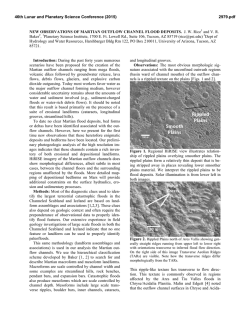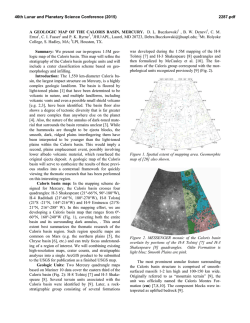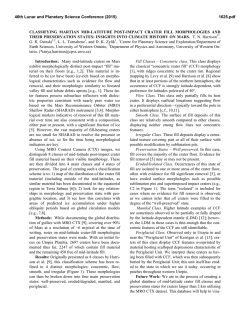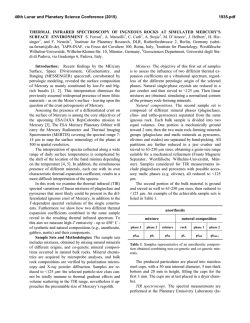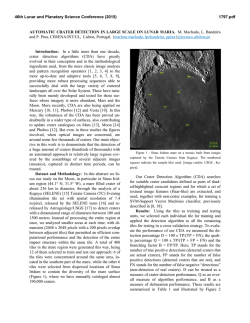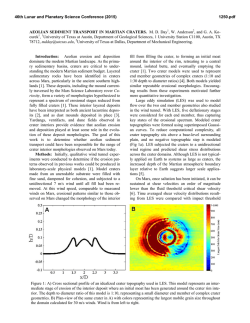
Near-Synchronous End to Global-Scale Effusive - USRA
46th Lunar and Planetary Science Conference (2015) 1731.pdf NEAR-SYNCHRONOUS END TO GLOBAL-SCALE EFFUSIVE VOLCANISM ON MERCURY Paul K. Byrne1,2, Lillian R. Ostrach3, Brett W. Denevi4, Clark R. Chapman5, Caleb I. Fassett6, Jennifer L. Whitten7, Christian Klimczak8, Erwan Mazarico3, Steven A. Hauck, II9, James W. Head7, and Sean C. Solomon2,10. 1Lunar and Planetary Institute, Universities Space Research Association, Houston, TX 77058 ([email protected]); 2Department of Terrestrial Magnetism, Carnegie Institution of Washington, Washington, DC 20015; 3Solar System Exploration Division, NASA Goddard Space Flight Center, MD 20771; 4The Johns Hopkins University Applied Physics Laboratory, Laurel, MD 20723; 5Department of Space Studies, Southwest Research Institute, Boulder, CO 80302; 6 Department of Astronomy, Mount Holyoke College, South Hadley, MA 01075; 7Department of Earth, Environmental and Planetary Sciences, Brown University, Providence, RI 02912; 8Department of Geology, University of Georgia, Athens, GA 30602; 9Department of Earth, Environmental, and Planetary Sciences, Case Western Reserve University, Cleveland, OH 44106; 10Lamont-Doherty Earth Observatory, Columbia University, Palisades, NY 10964. Introduction: The volcanic character of Mercury was affirmed when the MESSENGER spacecraft returned observations of the planet during its three flybys in 2008–10. Smooth plains units were identified across Mercury, and embayment relations, spectral contrast with surrounding terrain, and morphologic characteristics indicated that the majority of these plains are volcanic in origin [e.g., 1]. Orbital data have allowed the global distribution of these plains units to be characterized [2] (Fig. 1). The largest such deposits are located in the northern hemisphere and include the extensive northern plains (NP) and the Caloris interior and exterior plains (with the latter likely including basin material). Crater size– frequency analyses have shown both the NP and the Caloris interior deposits to be, within statistical error, around 3.8 Ga [2–6], for any of the published chronology models for Mercury [e.g., 7]. The areal density of impact craters (for a given range of crater diameters) for the NP and Caloris plains is comparable to corresponding values for other smooth plains deposits across Mercury, implying that these latter units are of a similar age [2,4,6,8]. To test whether this age marked a period of globally distributed volcanic resurfacing on Mercury, we determined crater size–frequency distributions for six additional smooth plains units, primarily in the planet’s southern hemisphere, interpreted as volcanic. Crater Size–Frequency Analysis: These six sites are shown in purple in Fig. 1, and their areas are given in Table 1. Each site hosts two populations of impact craters, one that postdates plains emplacement and one that consists of partially to nearly filled craters that predate the plains. This latter population indicates that, in each case, considerable time elapsed between formation of the underlying basement and the plains. The largest region of smooth plains at high southern latitudes we investigated is situated proximal to (and so named for) the Alver and Disney impact basins [9]. Farther west, a smaller patch of smooth plains is not obviously associated with an impact structure and so is termed here the “southern plains.” The largest unit of any of those we examine is located at mid-latitudes in the southern hemisphere, and is superposed by the 80-km-diameter Debussy impact basin. In the western hemisphere, smooth plains units Fig. 1. Mapped smooth plains deposits on Mercury [after 2], color-coded as follows. Purple: The sites we assess in this study. Blue: Other plains units for which crater counts have been published [2,4,6,8]. Pink: Remaining smooth plains units. The map is in a Robinson projection centred at 0°E; the graticule is shown in 30° increments of latitude and longitude. 46th Lunar and Planetary Science Conference (2015) within the Beethoven and Tolstoj basins constitute two additional sites; earlier studies have also reported crater data for Beethoven [2,8]. The northernmost site encompasses, but extends far beyond, the 168-kmdiameter Faulkner basin, for which earlier crater areal density data also exist [2]. Results: We give in Table 1 our crater measurements for each site in terms of N(10), the number of craters 10 km in diameter or greater per 106 km2 [e.g., 6]. This approach has the benefit of allowing direct comparison of disparate sites without the use of a particular model production function. (We give confidence intervals of ± one standard deviation, taken to equal the square root of the number of craters normalized to an area of 106 km2 [e.g., 4]). Table 1. Smooth plains N(10) data from this study Site N(10) Area (km2) 132 ± 20 3.4 × 105 Alver/Disney 100 ± 18 3.0 × 105 Beethoven 161 ± 20 4.2 × 105 Debussy 39 ± 10 3.6 × 105 Faulkner 53 ± 27 7.5 × 104 Southern plains 45 ± 20 1.1 × 105 Tolstoj The six sites fall into two groups by N(10), with higher counts (within error) for the plains at Alver/Disney, Beethoven, and Debussy than for those at Faulkner, southern plains, and Tolstoj. However, the plains at Faulkner host a greater number of secondary impact craters than at any of the other sites; our efforts to exclude secondaries at Faulkner from our count, on the basis of their occurring in chains and clusters, may have contributed additional uncertainty in the N(10) value we calculated for that site. Additionally, the southern plains and Tolstoj units are substantially smaller than, and so their N(10) values may not be as statistically robust as, the other units in this work. Nonetheless, the collective span of N(10) we give here is comparable to previously reported values for these and other volcanic smooth plains, and substantially lower than the range found for several intercrater plains units on Mercury (Table 2). Table 2. Smooth plains N(10) data from earlier work Site N(10) Source 82 ± 19 | 77 ± 24 [2] | [8] Beethoven 58 ± 13 | 75 ± 7 [2] | [4] Caloris interior plains 91 ± 16 [2] Caloris exterior plains 58 ± 18 [2] Faulkner 67 ± 4 [6] Northern plains 103 ± 19 | 110 ± 23 [2] | [8] Rembrandt 51 ± 23 [2] Rudaki 154 ± 34 → 370 ± 53 [8] Intercrater plains 1731.pdf Importantly, although a small deposit in Rachmaninoff basin may be as young as 1 Ga [10], we have yet to identify widespread (e.g., >1 × 105 km2) effusive volcanic deposits anywhere on Mercury with resolvably lower N(10) values than those we report. Planet-wide Cessation of Effusive Volcanism: It has long been noted that many volcanic smooth plains units on Mercury, including the Caloris interior plains and those in Beethoven, Rembrandt, and Tolstoj, are situated within pre-existing impact basins and craters [e.g., 9]. So, too, are many smaller deposits across the planet (shown in pink in Fig. 1), at least some of which are likely volcanic. This collocation of many of the youngest effusive volcanic units on Mercury with impact structures is consistent with predictions for a planet in contraction from secular interior cooling [11]. Global contraction induced a state of net horizontal compression in Mercury’s lithosphere, inhibiting the vertical ascent and eruption of magma [12]. However, the impact process would not only have deposited impact heat at depth, but would have removed overburden, heavily fractured the lithosphere, and reset stresses locally—making impact structures prime sites for late-stage eruptions in a tectonic regime otherwise generally unfavorable to extrusive activity. The texturally distinct volcanic smooth plains across Mercury might reflect a phase of peak magma generation [e.g., 13], or instead may simply have arisen from the rapidly waning impact flux toward the end of the Late Heavy Bombardment of the inner Solar System [14]. Nonetheless, global contraction likely was underway by this time [15] and may account for the absence of resolvably younger, widespread effusive volcanic deposits on Mercury [12]. If the rate of magma production after the onset of global contraction remained unchanged, the ratio of intrusive to extrusive material may be greater for the innermost planet than for bodies with longer histories of effusive volcanism [e.g., 16]. References: [1] Head J. W. et al. (2008) Science, 321, 69– 72. [2] Denevi B. W. et al. (2013) JGR Planets, 118, 891–907. [3] Head J. W. et al. (2011) Science, 333, 1853–1856. [4] Fassett C. I. et al. (2009) EPSL, 285, 297–308. [5] Strom R. G. et al. (2011) PSS, 59, 1960–1967. [6] Ostrach L. R. et al. (2014) Icarus, doi:10.1016/j.icarus.2014.11.010. [7] Le Feuvre M. and Wieczorek M. A. (2011) Icarus, 214, 1–20. [8] Whitten J. L. et al. (2014) Icarus, 241, 97–113. [9] Fassett, C. I. et al. (2012) JGR, 117, E00L08. [10] Prockter L. M. et al. (2010) Science, 329, 668–671. [11] Solomon, S. C. (1978) GRL, 5, 461–464. [12] Wilson L. and Head J. W. (2008) GRL, 35, L23205. [13] Michel N. C. et al. (2013) JGR Planets, 118, 1033–1044. [14] Marchi S. et al. (2013) Nature, 499, 59–61. [15] Banks M. E. (2014) LPS 45, abstract 2722. [16] Greeley R. and Schneid B. D. (1991) Science, 254, 996–998.
© Copyright 2025

